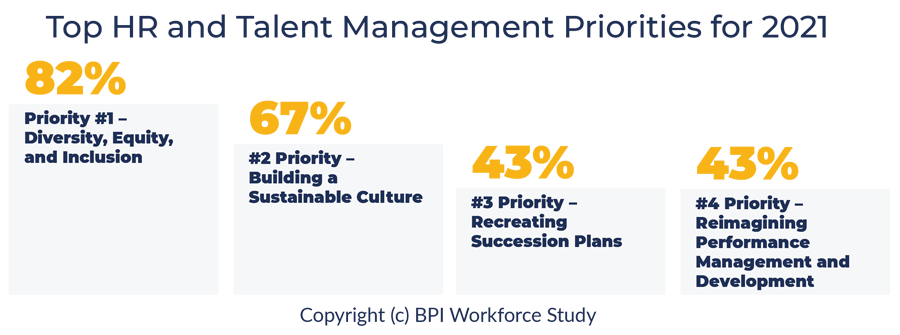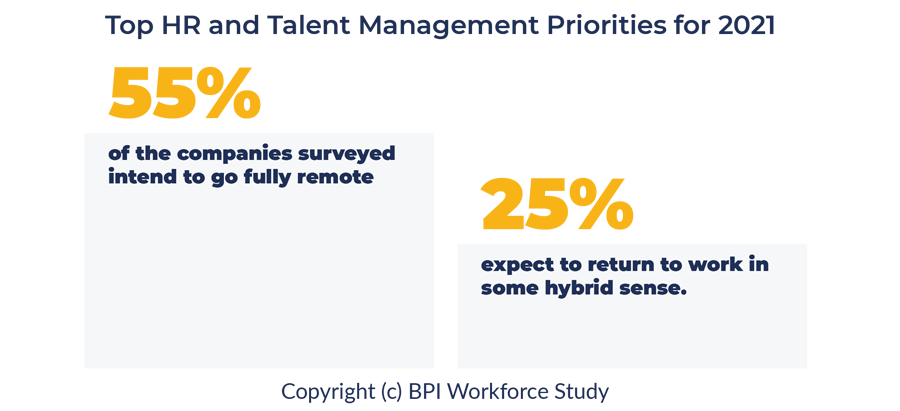We search for resolution, some hope that we can put a date on the start of the “new normal.” However, this assumption ignores how much events have changed us and the world in which we work.
Before these exacting days, Chief Human Resources Officers and Talent Managers set logical priorities that rolled their existing plans forward. Like other business officers, they preferred charts, trend lines, and trajectories. They sought incremental progress on the several accountabilities in their respective wheelhouses.

Priority #1 – Diversity, Equity, and Inclusion
82% of our survey participants look forward to improving their Diversity, Equity, and Inclusion profile. On one plane, this means recruiting, placing, and promoting underrepresented minorities. However, it means more.
Most professionals have moved beyond an Affirmative Action concern about auditing numbers and compliance. It admits the need to embrace values added by more fully diverse insights and inputs. This move seeks to include diverse backgrounds, experiences, and frames of reference.
Diversity and Inclusion by the numbers do not assure Equity. As social injustice concerns reach the streets in 2020, executive leaders face an adjustment in corporate conscience. CHO and Talent Officers are stepping up to refining policy statements and training management to redefine accountabilities.
However, they also find some challenges in aligning behaviors with emerging language and redefining standards. So much must grow and change to fulfill unspecified needs. It is a “puzzlement.”
Diversity and Inclusion by the numbers do not assure Equity.
As corporations assess the effectiveness of a remote workforce created by the COVID-19 pandemic, they inadvertently expanded their labor pool. They took advantage of talent willing to work remotely, happy to enter jobs denied by transportation, family obligations, or location. For example, one company pursued talent among military spouses who could work anywhere they had an internet link.
Organizations wrestle with how to sustain equitable compensation and benefits across multiple local regulations. However, their more considerable concern has focused on aiding worker wellbeing for those stressed by the changing environment and behavior.
Remote work, however, has not solved the increased unemployment among retail and hospitality industries. As these companies shed employees, they also increased unemployment among marginalized classes, including those in minimum wage positions. Many of these jobs will disappear, but CHRO officers hope to restore workforces with talent anxious to work under redefined workplace conditions.
Heads-up HR leaders see an opportunity here to do more than tweak existing policies. They see a chance to reimagine and restructure policies shaped by social issues raised during recent years. They feel pressed to drive their respective workplaces forward with relevant language, altered corporate behaviors, and leadership aligned with revitalized values.
These struggles with Diversity and Equity must extend to Inclusion. Legacy approaches assumed Inclusion would follow from Diversity and Equity. However, the workforce diaspora created by pandemic lockdowns discovered a new problem. Remote workers have concerns about how their role fits with new company directions. Absent from the comfort of their familiar breakroom, watercooler, and cubicle, they worry about their future among managers who cannot see them. They report fatigue with virtual meetings and increased stresses from children and working conditions.
Physically distanced, remote workers do not feel included. Without in-person contact, some feel ignored and overlooked. Some attach those feelings to real or perceived issues of race and social injustice. Leading HR strategists hope to create psychologically safe forums where employees can air these felt threats. Ironically, they may not advance Inclusion without including the insights of the excluded.
Making this work requires everyone to leave their comfort zone. “It means getting people into a room (or mindset) to build a foundation. All stakeholders must understand what it is and what it is not; they need definition, a shared understanding, and a culture strengthened by emotional connectedness” (Carter, 10 Top Tips, 2020)
#2 Priority – Building a Sustainable Culture
67% of the HR and Talent professionals surveyed seek to build a sustainable culture among a population fundamentally altered by the continuing effects of 2020 events. For them, these leaders expect no return to normal and feel duty-bound to define a future. They seek solutions that will grow beyond the current without ignoring its lessons.
Our conversations have focused on what culture co-collaboration can ensure. These professionals do not claim moral or ethical leadership. However, they believe a workplace culture can provide a leveled playing field where reasonable people can meet. They have confidence in the capacity of workers to clarify their wants and needs.
Management must listen to those voices, seeking diverse, equitable, and inclusive inputs, insights, and feedback. CHRO executives need not present themselves as the corporation’s conscience or moral authority. However, they can monitor and master the conversation.
If most organizations continue a hybrid basis, workplace culture will adjust. The change tasks leadership with sustaining its best features and rebuilding its effectiveness under altered conditions. The assumption that things will “return to normal” only seeks to retain a company culture, a spirit embodied in its branding.
However, while their brands may continue, the employee connection is at risk. Our BPI participants assert that culture is not tied to place, but shared workplace proximity does facilitate community. Maintaining the community with remote or hybrid work creates unforeseen challenges.
Executive officers must create a culture for their emerging reality. They have discovered functioning cultures in established organizations, but they must now design them for a community that has not yet fully formed. Consequently, the strategists among them push CEOs and Boards to model behaviors consistent with affirmed organizational values. HR strategists see no need to restate or rephrase core values, visions, and missions. They press, instead, for more vital adherence by senior management.
People need the confidence that things are okay.
My research before and after In Great Company (Carter, 2019)found power in emotional connectedness. It confirms that emotional connectedness can bridge the cracks and gaps in culture wrought by recent seismic shifts. People who enjoy working with each other in an environment of psychological safety and mutual respect sustain the most productive culture.
However, sustaining this engagement and self-perpetuating improvement requires a new commitment by head leadership. Participants refer to the CEO who drops in on Zoom meetings or the direct calls CEOs make to acknowledge worker and team achievement. Workers need confidence in leaders who live the organization’s values, and it takes frequent quality contact to assure their sense of belonging. “People need the confidence that things are okay” (Carter, How to create, 2021).
#3 Priority – Recreating Succession Plans
47% of a respected group of senior HR and Talent masters expect to recreate their organizations’ succession plans. Two motives drive them. First, many businesses have seen their succession pipelines burst because of pandemic fatalities among their promising talent. Second, the “going forward” following pandemic impact, social injustice, and political divisiveness means redrawing org charts and the positions charted there.
The spread of COVID-19 damaged organizations broadly and deeply. Some lost key executives and talent to the plague. However, sustaining their succession plans requires leadership involvement in reassessing existing talent considering emerging needs and expectations. They cannot merely hire hands and feet to replace lost high potentials.
Assuming succession plans focus on the top 10 to 15 percent of the organization’s positions, the succession strategy must weigh its role in the emerging ecosystem. This future will design new job positions, reframe existing ones, and compete for the necessary talent.
Succession strategies must structure work aligned with meaningfulness and purpose.
As the national culture seeks healing, its subcultures must picture a succession strategy that builds bridges. Succession plans need people, skills, and capabilities to resolve differences and inequities. Succession strategies must structure work aligned with meaningfulness and purpose. Recruiters, then, must mine labor pools for talents with this human edge regardless of their functional expertise. Finance, Operations, Marketing – each functional silo needs talents experienced in Diversity, Equity, and Inclusion under volatile stresses.
However, it is not enough to feed the pipeline. HR and Talent leaders must redefine the positions in a likely succession chain. Internal and external impacts will affect the tasks and responsibilities that have defined CEOs, EVPs, and other organization leaders in the past. Organizations need leadership capable of executing transformation on the human level as well as sustaining shareholder P&L. The senior officers we meet with see healthy opportunities in these emerging infrastructures.
#4 Priority – Reimagining Performance Management and Development
43% of CHOs and Talent officers surveyed see challenges in reimagining performance management and development. They tell us that sending people to work from home has triggered concerns about performance assessment. The challenges are strategic and tactical.
Remote workers let HR know that their performance deserves assessment more meaningful than counting their hours or clicks. Even those with near-automated work duties feel managers owe them more than severe metrics. Moreover, they worry that their absence from the workplace takes them beyond management’s observation.
HR officers find opportunities here. They see a chance to revisit the whole employee performance assessment process. These experts suggest optimizing the phone or virtual meeting context:
· having managers drop in on team meetings,
· expecting managers to recognize and reward achievement in real-time, and
· fostering collaboration between managers and workers on performance goals and metrics.
They urge managers to develop tools and methods for more frequent performance appraisals. They imagine a range of tools – some quick and some deep. For example, they encourage managers to show respect and honor achievement on every contact and conduct scheduled mini sessions one-on-one with a fuller annual review.
Managers must master virtual utilities so they can lead from a distance.
Training and Development present other issues. HR leaders, Talent managers, and T&D executives recognize the challenge in providing and sustaining worker-friendly development. They are in the market for software, training, and platforms geared to enhancing the worker experience. They hope to find a universally acceptable venue for trouble-free virtual meetings so they can reduce user burnout.
They have also developed a critical concern for training managers in new realities. They must develop skills to interact effectively and fruitfully with others. Our professionals point to homeschooling as an example that it is not enough to connect. Homeschooling needs teachers who can innovate with a medium in which they have not trained.
An integrating priority – value-added alignment

55% of the companies surveyed intend to go fully remote, and 25% expect to return to work in some hybrid sense. However, whatever any single organization has learned from their recent experiences does not stand as prototypical. Any action that has succeeded in response to 2020 events is relative to its climate, context, and current environment.
… any instability and uncertainty remain opportune for leaning into and moving forward with invention and innovation.
Predictions, then, have limited value. However, any instability and uncertainty remain opportune for leaning into and moving forward with invention and innovation. Leading HR and Talent executives have stepped up to the challenge, leveraging an organization’s espoused values to drive alignment. With things scattered to the winds by pandemic and lockdown, they see healing and unity in respect for and connectedness with core values.
Works Cited
Carter, L. (2019). In Great Company: how to spark peak performance by creating an emotionally connected workplace. New York: McGraw Hill Education.
Carter, L. (2020). 10 Top Tips: Achieving and Accelerating Diversity & Inclusion in Challenging Times. Retrieved from Best Practice Institute: https://blog.bestpracticeinstitute.org/10-top-tips-achieving-and-accelerating-diversity-inclusion/
Carter, L. (2021). How to create and sustain the right culture for your company. Retrieved from Best Practice Institute: https://blog.bestpracticeinstitute.org/how-to-create-and-sustain-the-right-culture-for-your-company/










